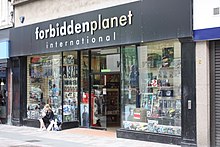Irish comics
| Irish comics | |
|---|---|
| Publishers |
|
| Publications |
|
| Creators |
|
| Series | |
| Languages | Irish English |
| Part of a series on the |
| Culture of Ireland |
|---|
 |
| History |
| People |
| Mythology and folklore |
| Religion |
| Art |


An Irish comic (Irish: greannán) is a periodical published in Ireland that contains comic strips. Ireland's comic book market has historically been very small, and closely linked to the British market. In recent years, many comics have been released with themes drawn from Irish mythology and history. The Irish comic industry has its roots in Irish nationalism and Irish Catholicism. Most comics are in English, but some in the Irish language have also been produced.[4] Authors have often portrayed Cú Chulainn and the like as superheroes, and made explicit connection between them and Irish revolutionaries.[5]
Several Irish artists and writers have produced comic books for British publishers, most notably P. J. Holden, Malachy Coney, Jim Fitzpatrick, Will Sliney, Will Simpson and Davy Francis.
History
[edit]The Congregation of Christian Brothers published Our Boys between 1914 and 1990, a version of Boys' Own informed by Irish nationalism and Catholicism.[6] From 1937 to 1979 it included Tír na nÓg ("Land of the Young"), an Irish-language insert.[7][8][9]
An early example of Irish comics was Nuada of the Silver Arm, a telling of the legend of Nuada Airgetlám by Jim Fitzpatrick that was serialised in the Sunday Independent in 1974–75; it was criticised for its violence and nudity by conservative Irish readers.[10]
Sláine, an Irish hero created by Pat Mills, first appeared in 1983 in 2000AD.[11]
Colmán Ó Raghallaigh was the first person to produce and publish a graphic novel in Ireland, through his own publishing house, Cló Mhaigh Eo ("Mayo Press"): An Sclábhaí ("The Slave") told the early life of Saint Patrick.[10]
See also
[edit]References
[edit]- ^ bug, ambush. "AICN COMICS REVIEWS: ARCHER & ARMSTRONG! LOVECRAFT! SUPERMAN! & MUCH MORE!". Aint It Cool News.
- ^ "Making Irish Fun: Coimicí Gael". 13 December 2012.
- ^ Molcher, Michael (11 November 2015). 2000 AD: The Creator Interviews - Volume 02. 2000 AD Books. ISBN 9781849979849 – via Google Books.
- ^ "Image+ #15". Image Comics. 28 June 2017 – via Google Books.
- ^ Burke, Liam; Gordon, Ian; Ndalianis, Angela (13 December 2019). The Superhero Symbol: Media, Culture, and Politics. Rutgers University Press. ISBN 9780813597188 – via Google Books.
- ^ Burke, Liam; Gordon, Ian; Ndalianis, Angela (13 December 2019). The Superhero Symbol: Media, Culture, and Politics. Rutgers University Press. ISBN 9780813597188 – via Google Books.
- ^ Raftery, Deirdre; Clarke, Marie (3 October 2018). Transnationalism, Gender and the History of Education. Routledge. ISBN 9781315446066 – via Google Books.
- ^ Oireachtas, Houses of the (11 February 1960). "Ceisteanna—Questions. Oral Answers. - Grants to Irish Language Publications. – Dáil Éireann (16th Dáil) – Thursday, 11 Feb 1960 – Houses of the Oireachtas". www.oireachtas.ie.
- ^ Rossiter, Nicky (13 November 2013). The Little Book of Wexford. History Press. ISBN 9780752498119 – via Google Books.
- ^ a b "The Portrayal of Irish Mythology and Prehistory in Graphic Storytelling – Irish Imbas Books". irishimbasbooks.com. 31 May 2019.
- ^ Fennell, Jack (31 January 2020). Rough Beasts: The Monstrous in Irish Fiction, 1800-2000. Oxford University Press. ISBN 9781789620344 – via Google Books.
